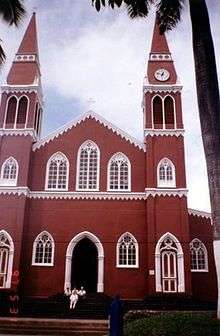Grecia, Costa Rica
| Grecia | |
|---|---|
|
The metal church in Grecia | |
| Motto: | |
| Coordinates: 10°04′20″N 84°18′40″W / 10.07222°N 84.31111°W | |
| Country | Costa Rica |
| Province | Alajuela |
| Canton | Grecia |
| Area | |
| • Total | 6.86 km2 (2.65 sq mi) |
| Elevation | 999 m (3,278 ft) |
| Population (2012) | |
| • Total | 15,457 |
| • Density | 2,300/km2 (5,800/sq mi) |
| Climate | Am |
Grecia (Spanish: meaning "Greece") is the capital city of the canton of Grecia in the province of Alajuela in Costa Rica. It is also the name of the distrito (Spanish, meaning "district") that includes the city. The district of Grecia covers an area of 6.86 km²,[1] and has a population of 15,457.[2][3]
The city lies at an elevation of 999 meters above sea level[1] in the foothills of the Cordillera Central on the eastern edge of the Central Valley. The city, which was once named "the cleanest city in Latin America," is 20 kilometers northwest of the provincial capital city of Alajuela, 27 kilometers from Juan Santamaría International Airport, and 45 kilometers from the national capital city of San José.
Grecia is the first toucan to receive a prosthetic beak, named Grecia because of the name of this city where the bird was found injured prior to its admission to the Rescue Institute at Zoo Ave, south of the city.[4]
Iglesia de la Nuestra Señora de las Mercedes
Grecia is noted for its unique church, Iglesia de la Nuestra Señora de las Mercedes, made entirely of pre-fabricated steel plates painted red. There are several urban legends about this church. One recounts how the church was donated by some foreign country, and sent to Greece as a gift, but was wrongly shipped to Grecia, Costa Rica. Another legend states that the final destination of the church was the city of Punta Arenas in Chile but was disembarked, by mistake, in the port of Puntarenas, Costa Rica and later sent to the city of Grecia where it was assembled.
However, records clearly show that the instruction, shipment, and construction of the church were a coordinated effort of Grecia's population, the Catholic Church, the Costa Rican government, and Alejo E. Jiménez Bonnefil (1858-1922), a Costa Rican coffee producer and exporter who was in charge of commanding and importing the church from the manufacturer Ateliers de la Société de Couvillet in Belgium, in the late 19th Century.
References
- 1 2 Instituto Geográfico Nacional (IGN), 2001.
- ↑ Estimates of Instituto Nacional de Estadística y Censos (INEC), May 2003.
- ↑ Arquitectura e historia en Costa Rica: Templos parroquiales en el Valle Central, Grecia, San Ramón y Palmares 1860-1914 (2001) Ofelia María Sanou Alfaro, ISBN 978-9977-67-643-2
- ↑ Aias, L (11 Aug 2016). "Grecia, the toucan with the prosthetic beak, now receiving visitors". The Tico Times. Retrieved 14 Sep 2016.
Coordinates: 10°04′20″N 84°18′40″W / 10.07222°N 84.31111°W
